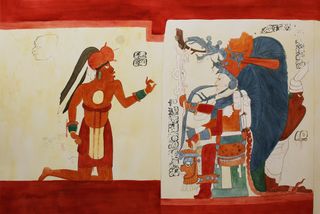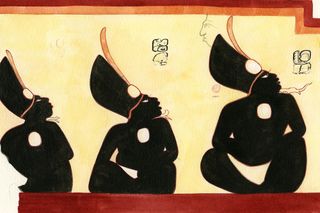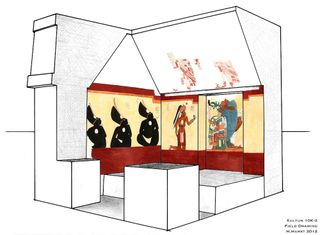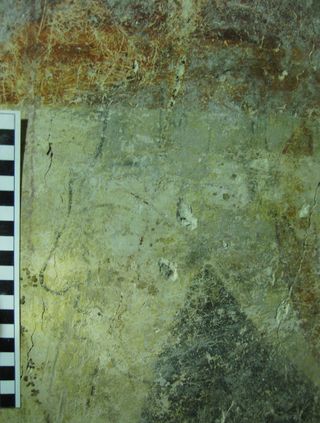Photos: Maya Mural Depicts Royal Advisors
Most Maya murals feature the royal family, but a rare find in northeastern Guatemala shows a mysterious group of men, called obsidians, advising the king. The mural, painted on the walls of a rectangular room found in the Maya city of Xultun, was likely the obsidians' residence, also includes paintings of tables and calendar systems. [Read the full story on the Maya mural]
Royal consultation

A man with the title "junior obsidian" kneels before the king. The king wears an enormous blue headdress and holds what is likely an incense bag, called a censer, in his hand. The staff has the symbol for wind, and the text around him affirms that the ruler is impersonating a wind god. Both figures are roughly half of life size, the researchers said. (Image credit: Illustration by Heather Hurst, copyright 2014)
Three sages

The three obsidians sit cross-legged and watch as the junior obsidian kneels before the king. The first man (left) does not have a title, but the second man (middle) is called a "youth." The third man (right) is called "senior obsidian." The titles suggest the obsidian had a ranking system, the researchers said. (Image credit: Illustration by Heather Hurst, copyright 2014)
A room with a view

This illustration shows a view of the northern and western walls in the Xultun mural chamber. The skeleton of a man who is dressed like the obsidian painted onto the western wall was found buried in the room. (Image credit: Illustration by Heather Hurst, copyright 2014)
Sign up for the Live Science daily newsletter now
Get the world’s most fascinating discoveries delivered straight to your inbox.
Chamber blueprints

Looters damaged much of the south wall when they broke into the chamber, and tree roots and water damaged parts of the east wall. Two individuals can be seen standing above the king on the north wall. (Image credit: Illustration by Heather Hurst, copyright 2014)
Living color

The junior obsidian is shown here kneeling before the king. This mural was painted at the heyday of Maya society, called the Classic period. This period lasted from about A.D. 200 to A.D. 900, and the mural was likely painted in the 760s. However, evidence of the Maya civilization stretches back to 1200 B.C., and Maya people are still alive today in Guatemala and Mexico, the researchers said. (Image credit: Photograph by H. Hurst, 2012, courtesy of the San Bartolo-Xultun Regional Archaeological Project)
Western wall detail

A detail of a left-facing head, located just above the headdress on the senior obsidian is seen here. The room has many illustrations that are drawn over each other, suggesting that several orders of the obsidian probably lived in this room until it was converted into a burial chamber. After that, it was filled with earth and built on top of during ancient Maya times.
After studying the room, the researchers also filled it with dirt to help preserve the mural from the elements, the archaeologists said. (Image credit: Photograph by H. Hurst, 2012, courtesy of the San Bartolo-Xultun Regional Archaeological Project)
Follow Laura Geggel on Twitter @LauraGeggel. Follow Live Science @livescience, Facebook & Google+.

Laura is the archaeology and Life's Little Mysteries editor at Live Science. She also reports on general science, including paleontology. Her work has appeared in The New York Times, Scholastic, Popular Science and Spectrum, a site on autism research. She has won multiple awards from the Society of Professional Journalists and the Washington Newspaper Publishers Association for her reporting at a weekly newspaper near Seattle. Laura holds a bachelor's degree in English literature and psychology from Washington University in St. Louis and a master's degree in science writing from NYU.
Most Popular

